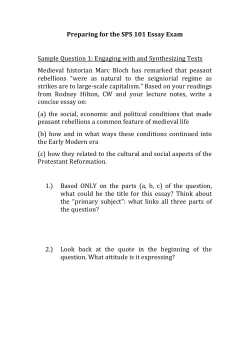
Confidence intervals for sample means
Confidence intervals for sample means 1. A study of commuting times reports the travel times to work for a random sample of 20 employed adults in New York State. The mean is ̅ = 31.25 minutes, and the standard deviation is s x = 21.88 minutes. What is the standard error of the mean? Interpret this value in context. 2. When two lights close together blink alternately, we “see” one light moving back and forth if the time between blinks is short. What is the longest interval of time between blinks that preserves the illusion of motion? Ask subjects to turn a knob that slows the blinking until they “see” two lights rather than one light moving. A report gives the results in the form, “mean plus or minus the standard error of the mean.” Data for 12 subjects are summarized as 251+ 45 (in milliseconds). (a) Find the sample standard deviation s, for these measurements. Show your work. (b) Explain why the interval 251+45 is not a confidence interval. 3. Breast-feeding mothers secrete calcium into their milk. Some of the calcium may come from their bones, so mothers may lose bone mineral. Researchers measured the percent change in bone mineral content (BMC) of the spines of 47 randomly selected mothers during three months of breast feeding. The mean change in BMC was 3.587% and standard deviation of 2.506%. (a) Construct and interpret a 99% confidence interval to estimate the mean percent change in BMC in the population. (b) Based on your results from part (a), do these data give good evidence that on average nursing mothers lose bone mineral? Explain. 4. The makers of Aspro brand aspirin want to be sure their tablets contain the right amount of active ingredient (acetylsalicylic acid). So they inspect a random sample of 36 tablets from a batch of production. When the production process is working properly, Aspro tablets have an average of µ = 320 milligrams (mg) of active ingredients. Here are the amounts (in mg) of active ingredient in the 36 tablets: 319 328 321 324 322 320 324 321 320 324 322 317 321 320 322 318 326 316 316 326 325 320 316 319 319 321 322 319 326 320 324 320 318 321 322 318 (a) What do these data tell us about the mean acetylsalicylic acid content of the tablets in this batch? (b) Afterwards, the makers are not happy about the sample size giving the true mean acetylsalicylic acid content of the tablets and ask for a larger sample to decrease the margin of error and also want more confidence. If the makers of the aspirin want a 99% confidence interval with a margin of error of 0.5 mg, what would the new random sample size be? Blast from Past: Choose a young person (aged 19 to 25) at random and ask, “In the past seven days, how many days did you watch television?” Call the response X for short. Here is the probability distribution for X: Days X: Probability: 0 1 2 3 4 5 6 7 0.04 0.03 0.06 0.08 0.09 0.08 0.05 ??? (a) What is the probability that X = 7? Justify your answer. (b) Calculate the mean of the random variable X. Interpret this value in context. (c) Suppose that you asked 100 randomly selected young people (aged 19 to 25) to respond to the question and found that the mean ̅ of their responses was 4.96. Would this result surprise you? justify your answer.
© Copyright 2025





















